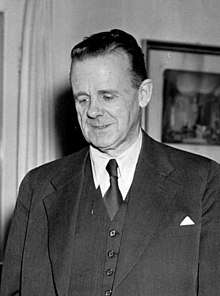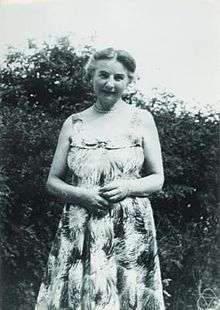Harald Cramér
Harald Cramér (Swedish: [kraˈmeːr]; 25 September 1893 – 5 October 1985) was a Swedish mathematician, actuary, and statistician, specializing in mathematical statistics and probabilistic number theory. John Kingman described him as "one of the giants of statistical theory".[1]
Harald Cramér | |
|---|---|
 Cramér at Stockholm University 1951 | |
| Born | 25 September 1893 |
| Died | 5 October 1985 (aged 92) Stockholm, Sweden |
| Nationality | Swedish |
| Alma mater | Stockholm University |
| Known for | |
| Spouse(s) | Marta Hansson |
| Children | Marie-Louise, Tomas, Kim |
| Awards | Guy Medal (Gold, 1972) |
| Scientific career | |
| Fields | Statistics, Probability theory, Number theory |
| Institutions | Stockholm University |
| Doctoral advisor | Marcel Riesz |
| Doctoral students |
|
Biography
Early life
Harald Cramér was born in Stockholm, Sweden on 25 September 1893. Cramér remained close to Stockholm for most of his life. He entered the University of Stockholm as an undergraduate in 1912, where he studied mathematics and chemistry. During this period, he was a research assistant under the famous chemist, Hans von Euler-Chelpin, with whom he published his first five articles from 1913 to 1914.[2] Following his lab experience, he began to focus solely on mathematics. He eventually began his work on his doctoral studies in mathematics which were supervised by Marcel Riesz at the University of Stockholm. Also influenced by G. H. Hardy, Cramér's research led to a PhD in 1917 for his thesis "On a class of Dirichlet series".
Academic professional career
Following his PhD, he served as an Assistant Professor of Mathematics at Stockholm University from 1917 to 1929. Early on, Cramér was highly involved in analytic number theory. He also made some important statistical contributions to the distribution of primes and twin primes. His most famous paper on this subject is entitled "On the order of magnitude of the difference between consecutive prime numbers",[3] which provided a rigorous account of the constructive role in which probability applied to number theory[4] and included an estimate for prime gaps that became known as Cramér's conjecture.
In the late 1920s, Cramér became interested in the field of probability, which at the time was not an accepted branch of mathematics. Cramér knew that a radical change was needed in this field, and in a paper in 1926 said, "The probability concept should be introduced by a purely mathematical definition, from which its fundamental properties and the classical theorems are deduced by purely mathematical operations."[5] Cramér took an interest in the rigorous mathematical formulation of probability in the work of French and Russian mathematicians such as Kolmogorov, Lévy, Bernstein, and Khinchin in the early 1930s. Cramér also made significant development to the revolution in probability theory.[5] Cramér later wrote his careful study of the field in his Cambridge publication Random variables and probability distributions which appeared in 1937. Shortly after World War II, Cramér went on to publish the influential Mathematical Methods of Statistics in 1946. This text was one that "showed the way in which statistical practice depended on a body of rigorous mathematical analysis as well as Fisherian intuition."[1]
In 1929, Cramér was appointed to a newly created chair in Stockholm University, becoming the first Swedish professor of Actuarial Mathematics and Mathematical Statistics. Cramér retained this position up until 1958.[6] During his tenure at Stockholm University, Cramér was a PhD advisor for 10 students, most notably Herman Wold and Kai Lai Chung. In 1950 he was elected as a Fellow of the American Statistical Association.[7] Starting in 1950, Cramér took on the additional responsibility of becoming the President of Stockholm University. In 1958, he was also appointed to be Chancellor of the entire Swedish university system. Cramér retired from the Swedish university system in 1961.
Actuarial career
A large portion of Cramér's work concerned the field of actuarial science and insurance mathematics. During the period from 1920 to 1929, he was an actuary for the life insurance company Svenska livförsäkringsbolaget. His actuarial work during this time led him to study probability and statistics which became the main area of his research.[8] In 1927 he published an elementary text in Swedish Probability theory and some of its applications. Following his work for Svenska livförsäkringsbolaget, he went on to work for Återförsäkringsaktiebolaget Sverige, a reinsurance company, up until 1948. He was also known for his pioneering efforts in insurance risk theory. After this period, he remained as a consultant actuary to Sverige from 1949 to 1961. Later in his life, he was elected to be the Honorary President of the Swedish Actuarial Society.[4]
Later years

Cramér remained an active contributor to his professional career for an additional 20 years. Following his retirement in 1961, he became extremely active in research, which had been slowed due to his Chancellorship. During the years from 1961 to 1983, Cramér traveled throughout the United States and Europe to continue his research, making significant stops at Berkeley, Princeton, and at the Research Triangle Institute of North Carolina.
Cramér received an Honorary Doctorate from Heriot-Watt University in 1972.[9]
His academic career spanned over seven decades, from 1913 to 1982.[10]
Harald Cramér married Marta Hansson in 1918, and they remained together up until her death in 1973. He had often referred to her as his "Beloved Marta". Together they had one daughter, Marie-Louise, and two sons, Tomas and Kim.
Notes
- Kingman 1986, p. 186.
- Heyde, Seneta 2001, p. 439.
- Cramér, Harald (1936), "On the order of magnitude of the difference between consecutive prime numbers" (PDF), Acta Arithmetica, 2: 23–46, doi:10.4064/aa-2-1-23-46
- Kendall 1986, p. 211.
- Blom 1987, p. 1340.
- Heyde, Seneta 2001, p. 442.
- View/Search Fellows of the ASA, accessed 2016-07-23.
- Blom 1987, p. 1334.
- webperson@hw.ac.uk. "Heriot-Watt University Edinburgh: Honorary Graduates". www1.hw.ac.uk. Retrieved 2016-04-07.
- Blom 1987, p. 1338.
References
- Cramér, Harald (1936). "Über eine Eigenschaft der normalen Verteilungsfunktion". Mathematische Zeitschrift (in German). 41 (1): 405–414. doi:10.1007/BF01180430. MR1545629
- Cramér, Harald (1938). "Sur un nouveau théorème-limite de la théorie des probabilités". Actualités Scientifiques et Industrielles (in French). 736: 5–23.
- Wegman, Edward (1986-11-01). "Some Personal Recollections of Harald Cramér on the Development of Statistics and Probability". Statistical Science. 1 (4): 528–535. doi:10.1214/ss/1177013531. JSTOR 2245807.
- Kingman, J. F. C. (1986). "Harald Cramér, 1893-1985". Journal of the Royal Statistical Society. 149 (2): 186. JSTOR 2981530.
- Blom, Gunnar (1987-12-01). "Harald Cramér, 1893-1985". The Annals of Statistics. 15 (4): 1335–1350. doi:10.1214/aos/1176350596. JSTOR 2241677.
- Kendall, David (1983). "A Tribute to Harald Cramér". Journal of the Royal Statistical Society, Series A. 146 (3): 211–212. JSTOR 2981652.
- Heyde, C.C.; Eugene Seneta (2001). Statisticians of the Centuries. New York, New York: Springer. pp. 439–443. ISBN 0-387-95283-7.
External links
- O'Connor, John J.; Robertson, Edmund F., "Harald Cramér", MacTutor History of Mathematics archive, University of St Andrews.
- photographs of Harald Cramér at the Oberwolfach Photo Collection
- Photograph with C. R. Rao from the PORTRAITS OF STATISTICIANS
- Harald Cramér at the Mathematics Genealogy Project